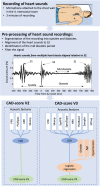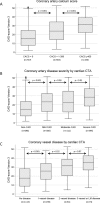Diagnostic performance of an acoustic-based system for coronary artery disease risk stratification
- PMID: 29122932
- PMCID: PMC5969347
- DOI: 10.1136/heartjnl-2017-311944
Diagnostic performance of an acoustic-based system for coronary artery disease risk stratification
Abstract
Objective: Diagnosing coronary artery disease (CAD) continues to require substantial healthcare resources. Acoustic analysis of transcutaneous heart sounds of cardiac movement and intracoronary turbulence due to obstructive coronary disease could potentially change this. The aim of this study was thus to test the diagnostic accuracy of a new portable acoustic device for detection of CAD.
Methods: We included 1675 patients consecutively with low to intermediate likelihood of CAD who had been referred for cardiac CT angiography. If significant obstruction was suspected in any coronary segment, patients were referred to invasive angiography and fractional flow reserve (FFR) assessment. Heart sound analysis was performed in all patients. A predefined acoustic CAD-score algorithm was evaluated; subsequently, we developed and validated an updated CAD-score algorithm that included both acoustic features and clinical risk factors. Low risk is indicated by a CAD-score value ≤20.
Results: Haemodynamically significant CAD assessed from FFR was present in 145 (10.0%) patients. In the entire cohort, the predefined CAD-score had a sensitivity of 63% and a specificity of 44%. In total, 50% had an updated CAD-score value ≤20. At this cut-off, sensitivity was 81% (95% CI 73% to 87%), specificity 53% (95% CI 50% to 56%), positive predictive value 16% (95% CI 13% to 18%) and negative predictive value 96% (95% CI 95% to 98%) for diagnosing haemodynamically significant CAD.
Conclusion: Sound-based detection of CAD enables risk stratification superior to clinical risk scores. With a negative predictive value of 96%, this new acoustic rule-out system could potentially supplement clinical assessment to guide decisions on the need for further diagnostic investigation.
Trial registration number: ClinicalTrials.gov identifier NCT02264717; Results.
Keywords: cardiac imaging and diagnostics; coronary artery disease.
© Article author(s) (or their employer(s) unless otherwise stated in the text of the article) 2018. All rights reserved. No commercial use is permitted unless otherwise expressly granted.
Conflict of interest statement
Competing interests: The current research is financed partly by Acarix A/S by an unrestricted grant. SES is a minor shareholder and part-time consultant in Acarix A/S. BSL is an industrial student at Acarix A/S. MB is part of the Acarix A/S advisory board. MB and SW received an unrestricted institutional research grant from Acarix A/S.
Figures





Similar articles
-
Likelihood reclassification by an acoustic-based score in suspected coronary artery disease.Heart. 2023 Jul 27;109(16):1223-1230. doi: 10.1136/heartjnl-2023-322357. Heart. 2023. PMID: 36878672 Clinical Trial.
-
Diagnosing coronary artery disease by sound analysis from coronary stenosis induced turbulent blood flow: diagnostic performance in patients with stable angina pectoris.Int J Cardiovasc Imaging. 2016 Feb;32(2):235-245. doi: 10.1007/s10554-015-0753-4. Epub 2015 Sep 3. Int J Cardiovasc Imaging. 2016. PMID: 26335368 Free PMC article.
-
Pre-test probability prediction in patients with a low to intermediate probability of coronary artery disease: a prospective study with a fractional flow reserve endpoint.Eur Heart J Cardiovasc Imaging. 2019 Nov 1;20(11):1208-1218. doi: 10.1093/ehjci/jez058. Eur Heart J Cardiovasc Imaging. 2019. PMID: 31083725
-
Meta-Analysis of Diagnostic Performance of Coronary Computed Tomography Angiography, Computed Tomography Perfusion, and Computed Tomography-Fractional Flow Reserve in Functional Myocardial Ischemia Assessment Versus Invasive Fractional Flow Reserve.Am J Cardiol. 2015 Nov 1;116(9):1469-78. doi: 10.1016/j.amjcard.2015.07.078. Epub 2015 Aug 14. Am J Cardiol. 2015. PMID: 26347004 Free PMC article. Review.
-
A novel approach to diagnosing coronary artery disease: acoustic detection of coronary turbulence.Int J Cardiovasc Imaging. 2017 Jan;33(1):129-136. doi: 10.1007/s10554-016-0970-5. Epub 2016 Aug 31. Int J Cardiovasc Imaging. 2017. PMID: 27581390 Review.
Cited by
-
Improved pre-test likelihood estimation of coronary artery disease using phonocardiography.Eur Heart J Digit Health. 2022 Oct 10;3(4):600-609. doi: 10.1093/ehjdh/ztac057. eCollection 2022 Dec. Eur Heart J Digit Health. 2022. PMID: 36710896 Free PMC article.
-
Economic Analysis of the CADScor System for Ruling Out Coronary Artery Disease in England.Pharmacoecon Open. 2022 Jan;6(1):123-135. doi: 10.1007/s41669-021-00297-0. Epub 2021 Aug 30. Pharmacoecon Open. 2022. PMID: 34460080 Free PMC article.
-
Experimental and numerical investigation on soft tissue dynamic response due to turbulence-induced arterial vibration.Med Biol Eng Comput. 2019 Aug;57(8):1737-1752. doi: 10.1007/s11517-019-01995-y. Epub 2019 Jun 8. Med Biol Eng Comput. 2019. PMID: 31177410
-
The Feasibility of Ultra-Sensitive Phonocardiography in Acute Chest Pain Patients of a Tertiary Care Emergency Department (ScorED Feasibility Study).J Pers Med. 2022 Apr 14;12(4):631. doi: 10.3390/jpm12040631. J Pers Med. 2022. PMID: 35455746 Free PMC article.
-
Diagnostic performance of a device for acoustic heart sound analysis in patients with suspected myocardial infarction.Open Heart. 2023 Mar;10(1):e002090. doi: 10.1136/openhrt-2022-002090. Open Heart. 2023. PMID: 36858602 Free PMC article. Clinical Trial.
References
Publication types
MeSH terms
Associated data
LinkOut - more resources
Full Text Sources
Other Literature Sources
Medical
Miscellaneous
